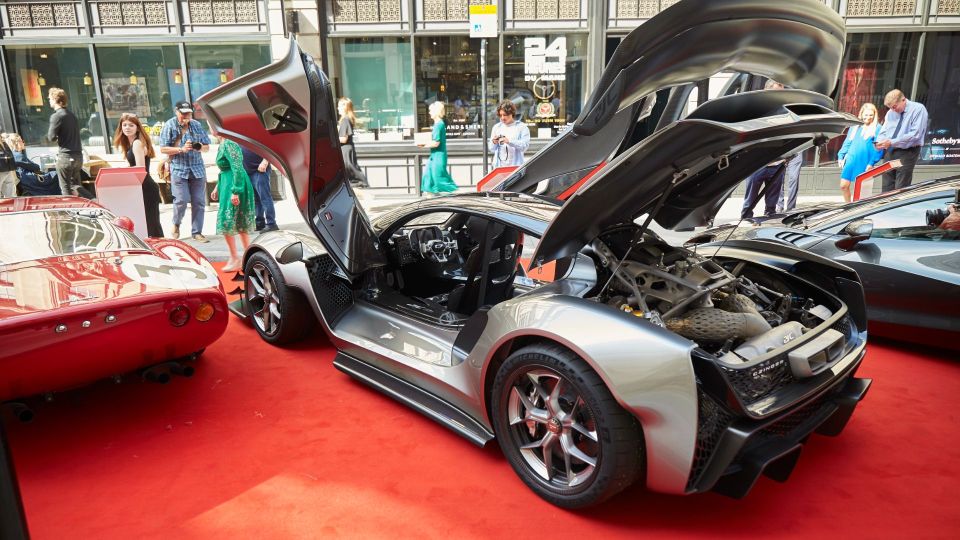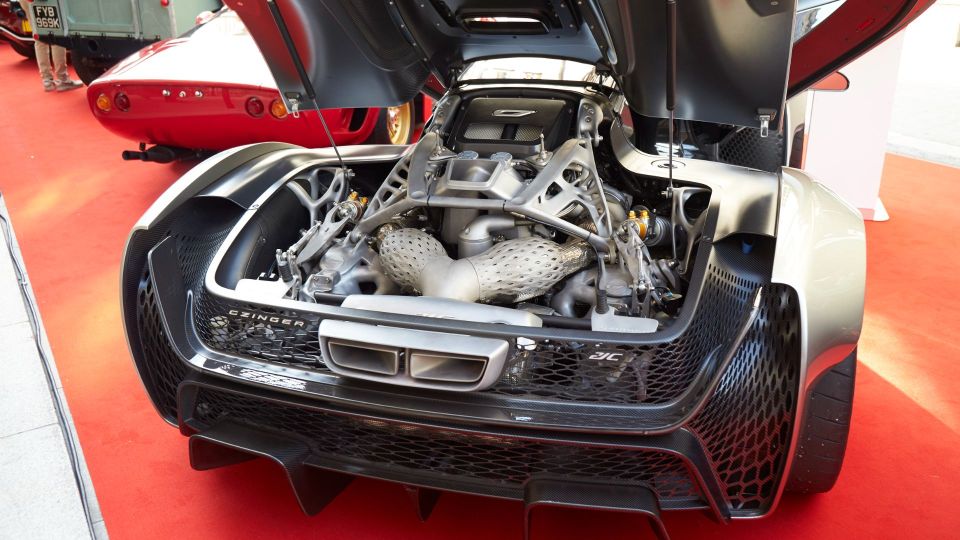Czinger 21C: 3D-printed hypercar makes red-carpet London debut

The radical Czinger 21C made its UK debut at this week’s Concours on Savile Row. The American hybrid hypercar shared a red carpet with 30 exotic and classic cars along one of London’s most famous streets.
Highlights of the two-day event included several rare Ferraris, the legendary Barnato-Hassan Bentley and the new McLaren Artura. However, the outrageous and otherworldly Czinger was arguably the main attraction.
According to company co-founder Lukas Czinger, who gave us a guided tour, it “pushes the boundaries of design, performance and sustainability”.
Ready for take-off

Styled like a fighter jet and scarcely any slower, the 21C has a central driving position with the passenger (or “co-pilot”, as Czinger likes to call them) sitting directly behind. The car’s aero-scuplted body is carbon fibre, while its chassis is made from 3D-printed composite parts.
Forward thrust comes from Czinger’s own 2.9-litre twin-turbo V8 – the world’s most power-dense production engine, which produces 330hp per litre and revs to 11,000rpm.
Factor in two torque vectoring 800-volt electric motors and the combined result is a ferocious 1,250hp, plus the ability to drive 12 miles in EV mode.
Perfect power-to-weight

With a kerb weight of 1,250kg, the 21C has a ‘perfect’ power-to-weight ratio of one horsepower per kilogram. It will hit 62mph in 1.9 seconds and reach a top speed of 253mph (just not on Savile Row, thank you).
Czinger has also set production car lap records at Laguna Seca and the Circuit of the Americas, where the 21C went six seconds faster than a McLaren P1.
Just 80 examples of the Czinger 21C will be made and UK sales are via H.R. Owen in Berkeley Square, Mayfair. If a Ferrari or Lamborghini seems a tad run-of-the-mill, expect to pay £1.8 million and take delivery towards the end of next year.
Now read on for our exclusive interview with Lukas Czinger at the Concours on Savile Row.

Why start a car company?
My dad [co-founder Kevin Czinger] and I have always had a passion for cars. His older brothers were Chevy mechanics and he grew up drag-racing American muscle cars.
My idol was Paul Walker in The Fast and the Furious, so my first car was a highly modified Mitsubishi Evo VIII. The innovations we developed in 3D printing allowed us to build a car without the enormous upfront investment that is usually required.
What makes the 21C different to other hypercars?
Above all, our unique production process – using 3D printing that is 20 times faster than the industry standard, plus patented bonding adhesives – makes for a stiffer, lighter and higher performance chassis. We’ve compressed a decade of automotive development into two years.

What inspired the car’s design and in-line seating configuration?
‘Form follows function’ was the rule here. We took on Nick Alcock, previously the lead aerodynamicist at Williams Advanced Engineering, to hone the car’s aero. The in-line configuration reduces frontal area and thus minimises drag. A central driving position also keeps the car perfectly balanced, which is ideal for high-speed track work.
Why did you develop a V8 engine in-house?
Mainly for packaging reasons. The engine compartment is a very tight fit and most off-the-shelf options were too wide. Our requirements in terms of power [950hp, plus 300hp from two electric motors] were very demanding, too.
Is the 21C primarily intended for road or track use?
The 21C is fully crash-tested and emissions-compliant, so it can be driven on the road. However, it truly shines when you take it on a track. The high-downforce specification seen on this car is especially suited to track use.
We also plan to reveal a low-drag version that is geared towards the road, with less fixed aero and a small amount of luggage space.
Did you benchmark the 21C against any rival hypercars?
Our car is unique, but we did check out others in the marketplace. In terms of quality, Bugatti was our benchmark. For on-track performance, we looked at the McLaren Senna. And for everyday usability on the road, our target was the McLaren 720S.

Could the 3D-printing build process be scaled up?
Absolutely. We are already working with eight major car manufacturers, including a very famous British brand. Outsourcing to our ‘digital production’ process is very attractive, as car companies only pay for what they use – and there’s no need for huge factories or long production lines. We’re moving into other industries as well, such as aerospace and defence.
What is next for Czinger?
Czinger will reveal a concept car at the Pebble Beach Concours this August. It’s a two-door, four-seat coupe, which will be higher volume and more affordable than the 21C. Our overall target is 10,000 cars a year. We want to become the American Ferrari.
Tim Pitt writes for Motoring Research